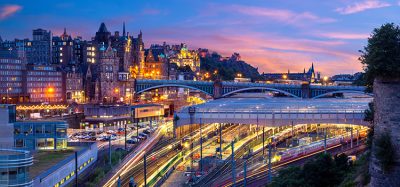High Speed 1: The First Anniversary
Posted: 3 December 2008 | | No comments yet
Looking back, it has been quite a year! I remember vividly, the enormous sense of pride I, my colleagues, guests and performers felt as on 6 November 2007, Her Majesty The Queen declared St Pancras International open and that the delivery of High Speed 1 (HS1) was complete… on time and within budget. However, as always, as one chapter closed, another begins. So began the journey of our first year of operation.
Looking back, it has been quite a year! I remember vividly, the enormous sense of pride I, my colleagues, guests and performers felt as on 6 November 2007, Her Majesty The Queen declared St Pancras International open and that the delivery of High Speed 1 (HS1) was complete… on time and within budget. However, as always, as one chapter closed, another begins. So began the journey of our first year of operation.
Looking back, it has been quite a year! I remember vividly, the enormous sense of pride I, my colleagues, guests and performers felt as on 6 November 2007, Her Majesty The Queen declared St Pancras International open and that the delivery of High Speed 1 (HS1) was complete… on time and within budget. However, as always, as one chapter closed, another begins. So began the journey of our first year of operation.
I was appointed as Managing Director of CTRL (UK) Ltd in November 2006, joining Britain’s largest ever single construction project and the first major railway project in this country for over a century. Section 1 of our first high-speed railway had been open since 2003 and while we were able to learn valuable lessons from this period of operation, Section 2, with over 30 kilometres of its length trailing beneath London, was going to have many more technical challenges as it negotiated, for example, 12 existing tunnels and over 600 gas mains. At over eight metres in diameter, the tunnels themselves were unfamiliar to the new operating and maintenance teams and the ventilation systems were all new. The approaches to St Pancras are complex and in this area alone we have 28 sets of points. Beyond those – and many other – technical considerations, the completion of High Speed 1 included the commissioning of two new stations at Stratford and Ebbsfleet and, of course, the completion of the restoration and modernisation of the magnificent St Pancras International. As well as being the new central London home for Eurostar services, the new St Pancras had over 50 shops, bars, restaurants and coffee houses in various states of completion. As the opening date approached, we had to get the right management structure in place.
By the early part of 2007, London & Continental Railways (LCR), led by Rob Holden as CEO, completed the organisational design for HS1 with the roles defined between ‘High Speed 1’ as the holder of the Concession Agreement and Network Rail (CTRL) as its operator. I began overseeing the process of bringing the railway to life and delivering on the promise we were committed to. All matters relating to project delivery remained with LCR subsidiary, Union Railways (North).
We created a Transition Management Team (TMT) with representatives from Eurostar, NR (CTRL), HS1 and representatives from the retailers at St Pancras International and charged this team with responsibility for all matters that related to the successful opening of operation. This included, testing in various scenarios with up to 5,000 volunteer “passengers”, station operation and maintenance (at St Pancras International, Stratford International and Ebbsfleet International), the phased retail opening schedule and what we termed “the golden period”, i.e. the first 100 days. The TMT also recognised that in shifting the focus from a project completion objective to an operational business model, meeting customers’ expectations was key. To that end, it was essential that we recognised who our key customers were. Moreover, we needed to support the core Eurostar objective of their customers experiencing markedly improved levels of service from the very first moment that the new faster services began on the morning of 14 November 2007. We had been very successful in publicising what people might expect from HS1; all we had to do now was meet those expectations and exceed them where possible.
Passenger numbers growth is linked tightly to customer satisfaction levels and as HS1 earns the majority of its income from track access charges, alongside income from station / retail income, this shapes the business from top to bottom. We inherited a legacy of putting the customer’s needs and wants at the forefront of our thinking and this remains central to the commercial model. We also, remained acutely aware that we should prioritise where possible.
The November opening events passed to massive ovation. With the marketing and publicity departments in full swing, the immediate challenge was how to sustain the very positive reception through the first 100 days – “the golden period”. During this time, the challenge of integrating further retail openings was overcome, as was the opening of the new subterranean “Thameslink Box” station for First Capital Connect services. Again, this was opened on schedule on 9 December 2007. Such was the success of this period that Gold Control (overseeing the challenge of the first 100 days) was stood down in early January, 45 days early – a major success. The focus then remained on completing the fit out for, opening and integrating the remaining retail units and continuing the drive for excellence in customer service.
Two sets of figures proved we were achieving outstanding results on both of these. First, in February, Eurostar released its three month results showing passenger numbers were up by over 20% and reliability and punctuality were also up. Secondly, St Pancras International commissioned detailed MORI polling of its customers. Headline results revealed that over 90% of travellers and visitors to the station were happy with their experience of the renovated and modernised station and we had already begun to see welcome growth in the numbers of repeat visitors to St Pancras International.
Our decision to prioritise and then phase-in the retail had worked. Through this strategy we had been able to manage workloads, focus attention where necessary and give customers as many reasons as possible to visit the station for the first time and to keep coming back. In April, The Betjeman Arms completed its fit out and opened as a fully working station pub (rather than the ‘Baby Betjeman’ that had existed from the start). However, with the opening of The Circle retail area and as such almost all the retail now open, while the station bedded down through a programme of summer events and openings, the HS1 railway faced its first major challenges.
The Railway has TVM 430 signalling throughout its length and this was proven and understood from the operation of Section 1. At St Pancras, the interfaces with the domestic network mean that we have KVB signalling and HPSS point machines. During the summer we began to experience faults linked to temperature and EMC issues. The signalling technicians and several specialists were able to isolate the cause and are in the process of remedying the component fault. The operations were able to use the flexibility within the track layout to ensure that Eurostar services continued to operate with minimal delays.
At the time of opening Section 2 we had a moving annual average delay per train of four seconds. Recognising the increased complexity, we set ourselves a target of 10 seconds per train after the first year of operation. At present, the moving annual average is 7.8 seconds per train and we are beginning to see a downward trend towards six seconds per train. This in my mind represents a superb performance and one that stands HS1 in good stead as traffic levels begin to rise.
Professionals and expert technicians throughout HS1 and NR (CTRL), who today include Dyan Crowther, whose team as well as those who went before them, have diligently built inherent resilience and operational flexibility into the design of this railway. All deserve high praise – we have a team whose competency and dedication does the UK high-speed rail pioneer engineers proud. In my view, they are second to none. Moreover, I would venture that this is a view now shared by the Train Operating Companies that we are pleased to play host to at St Pancras International: Eurostar; East Midlands Trains; First Capital Connect; and, soon to join us, Southeastern. I believe one of our biggest successes has been the integration of our skills with theirs as train operators to offer passengers the highest levels of reliability and punctuality. Yes, we are proud to have created at St Pancras International, Europe’s first ‘Destination Station’ and we are equally pleased that significant numbers of people come to St Pancras International with no intention of getting on a train. However, we cannot do this while at the same time forgetting our core customer, the train traveller. To that end, our first sets of improvements around the stations have primarily concerned improvements in signage as well as stepping up the programme to install cash machines, more public information points and more toilets.
Most recently, of course, St Pancras International and Eurostar endured their most challenging time since November 2007. On 11 September 2008, a fire on board a Eurotunnel freight shuttle closed the North Tunnel completely for several days and sections of it remain closed today. We will continue to work closely with Eurostar and Eurotunnel to help where we can to minimise disruption to passengers. I look back at the events of 11 September this year with considerable pride. The systems we had planned for and tested for worked. As the review process continues, what stood out for me was the way our staff worked with Eurostar staff and the retailers within St Pancras International to ensure a difficult time was not made any worse than it needed to have been and, indeed, for the vast majority of passengers and visitors to the station, their disruption was as minimal as it could have been given the circumstances. Of course, as this challenge moves to a much more manageable state, the turbulence in financial markets at home and abroad continue to offer an environment outside HS1 that currently defies prediction.
Nevertheless, whatever the climate, alongside running the railway, we continue to work with LCR to assist in putting definition and what certainty we can around the regulatory, charging and access arrangements that will form key parts of the value that investors will appraise as part of the planned sale of HS1. In September this year, we launched our second consultation to the industry and this will lead to an updated Network Statement and Charging Tariff being issued in the first part of 2009.
Meanwhile, things on the railway continue apace. We are working closely with Southeastern to introduce the high-speed domestic services that will begin sharing the high-speed line with Eurostar from December 2009. As part of the extensive testing programme by Southeastern and Hitachi, who are supplying the new 140mph Class 395s rolling stock, we are sharing our experience and planning to run shadow services from autumn 2009. These high-speed domestic services are being much anticipated – it is the first time a high-speed domestic service will be launched in the UK and it is already acting as a powerful catalyst for associated regeneration schemes both commercial and residential in Kent, east London and, of course, on land LCR owns at King’s Cross Central. It all adds up to an investment in regeneration, linked to High Speed 1, in excess of £10 billion.
Beyond next year, we are also well advanced in our planning for London hosting the Olympic Games in 2012. The new ‘Javelin’ shuttle trains that will be part of Southeastern’s high-speed domestic service during the Games themselves will ferry up to 25,000 officials, athletes and spectators to the Olympic park at Stratford from St Pancras International in just seven minutes. These shuttles will then continue on to Ebbsfleet International. It has already been widely acknowledged the role that the HS1 railway played in securing the Games for London and our role now is to continue to ensure the service integrates seamlessly.
Beyond that, HS1 needs to remain in the eyeline of International Open Access operators as we seek to further fill the capacity on HS1. At the same time, we remain mindful of the need to maintain HS1 as a viable offer for European gauge freight and express freight. It is a bright future indeed.
So, as we celebrate a full year of operation, we can look back at some of the challenges we have successfully overcome and some of the potential we have taken advantage of. However, everyone should be most proud of HS1 in terms of how it has demonstrated that high speed rail in the UK can work, that we can integrate successfully with the ever-expanding European high-speed rail network and that we can push rail both at home and abroad to the very forefront of political debate.
Manchester, Birmingham, Glasgow and other large urban centres north of London are investing in studies that recognise the role high-speed rail can play in promoting regeneration and economic growth.
That’s the power of high-speed rail … Roll on the next generation!







